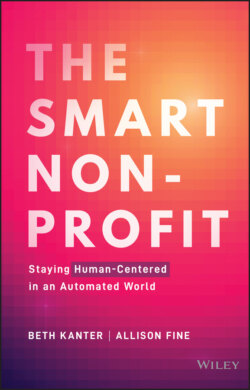Читать книгу The Smart Nonprofit - Beth Kanter - Страница 12
BECOMING A SMART NONPROFIT
ОглавлениеSmart nonprofits use a disciplined approach to adopting smart tech carefully and strategically while always maintaining the highest ethical standards and responsible use. Smart nonprofits are:
Human-centered: A human-centered approach means finding the sweet spot between people and smart tech, while ensuring that people are always in charge of the technology. Smart nonprofits ensure that the use of smart tech always aligns with their values.
Prepared: Organizations need to take intentional preparation steps. They must actively reduce bias embedded in smart tech code and systems. They also thoroughly correct and label data to be incorporated into a smart tech system. And lastly, they must have a formal process to select systems, vendors, and consultants that align with their organization's values.
Knowledgeable and reflective: Learning about what smart tech is and does is an ongoing process in the boardroom, the C-suite, and for nonprofit staffs. Once automated systems are in place, organizations need to be vigilant about whether they are performing as hoped or unintended consequences have arisen, and how clients and end users feel about the systems. We have embedded reflection questions throughout this book to help create the habit of asking important questions over time.
Working this way with smart tech creates a gift of new time.
Staff people spend about 30% of their time on administrative tasks. Smart tech is going to automate many of these tasks, thereby freeing up staff to do other things. This newly found time creates a choice for organizations. This new time could be used to do more of the same kinds of tasks that value efficiency over effectiveness and the number of people served over the number of problems solved. Or they can use this precious gift to become something new and better. We hope organizational leaders will choose the latter. We call this return on investment for the use of smart tech the dividend of time.6
Integrating smart tech into organizational functions could create an enormous return on investment that will allow for:
More time with clients: Instead of spending time checking off lists and filling out forms, case workers will spend more time with clients to understand the origins of their problems, the obstacles that get in the way of their success, and providing real-time support when life gets really hard.
Crisis prevention and reduction: Smart tech can help identify people at risk of becoming homeless before crises overwhelm them. For instance, the city of London, Ontario, uses a new smart tech system to track people at risk of becoming chronically homeless (with their permission) to prioritize services for them before a crisis.7 Smart tech will help forecast environmental disasters earlier and help with rescue operations. Resources will be directed to victims faster.
Deeper and more meaningful relationships with donors: Transactional fundraising, treating every donor like an ATM machine, has become the norm for too many organizations. Smart tech frees staff from updating donor bases and researching prospects to spending time getting to know donors in meaningful ways: learning more about their interests and the reasons your cause is important to them and turning these donors into ambassadors to recruit and nurture donors within their personal networks.
Reduced astroturfing: Advocacy organizations too often substitute marketing efforts for real grassroots organizing. For instance, the use of online petitions that is actually used to capture email addresses for future communications. Instead of “astroturfing” support for climate change, advocates could use the dividend of time to engage with supporters and get to know them, educate them on the issue, and teach them how to become advocates and create their own group of supporters.
More time to think: People and organizations are so busy doing the work, and the work to support the work, that there is very little time for reflection on how the work is done and how to improve it. Imagine having time to consider other ways to do intake with clients rather than furiously responding to a barrage of inquiries every day? Imagine having time to talk to supporters about what kind of support they would need to gather their friends and help them become ambassadors? Imagine having time to just think.
